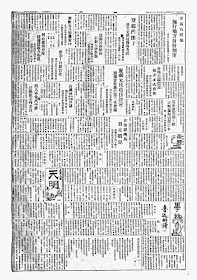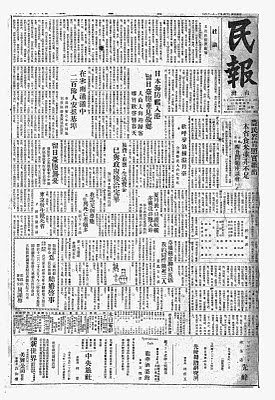
Even though 鄭成功Cheng Chen-Gong [國姓爺Koxinga] (1624-1662) is a household name in both Taiwan and China yet his life remains relatively unknown in the West. A few words here maybe appropriate:
Koxinga was a King who commanded a very well-structured military of some 100,000 men. He was 延平王 (King of Yan-ping) and whose war-machine was respected and feared at once by all who had crossed his path, unwittingly or otherwise. This path was actually a very narrow one: 反清復明[Rebel against Qing and restore Ming]. Period.
Koxinga was educated a Confucian scholar who later, at age 23, became a military leader under very trying circumstances: First his father 鄭芝龍Cheng Zhi-long surrendered to the Qing violating a cardinal Confucian rule of honoring thy emperor at all costs, then his Japanese mother 翁夫人Lady Wuon (aka Mrs 田川松Takawa Matsu氏, 翁 was her adoptive parent's name) committed suicide when the Qing invaded Koxinga's hometown. He burned his scholar's robes at the Confucius's Temple bidding farewell to a university student's life forever, and answered the personal call from the Ming emperor to rescue the latter's failing dynasty. The emperor-in-exile 隆武Long-wu rewarded him by conferring the honor to use the royal family name "朱" [hence 國姓爺 as he was respectfully referred to by the common people] - the emperor did not have any daughters to marry Koxinga into the royal family. And the last emperor-in-exile 永曆Yon-li promoted him to a second-tier kingship 延平王. The title 延平郡王 was a posthumous honor from the Qing emperor 光緒 in 1875 - by then all were forgiven and Koxinga was regarded a Chinese hero for driving away the Dutch from Taiwan. It was a politically expedient way of rallying the Taiwanese during the Sino-French war era that is to continue to this day. And whatever had happened to the Ming-Cheng soldiers in the penal colonies in mainland China has remained totally ignored, also to this day.
There were two main branches in Koxinga's military, the Navy and the Army. The Navy had 9 fleets reportedly with "hundreds" of vessels. One fleet, the 內司鎮 was directly under the flag of Koxinga. Larger warships in the 樓船鎮fleet were triple-deckers with fire power that could easily overwhelm the best of Dutch galeons and indeed had done so in the battle for the recovery of Taiwan. [Insert: a model of one of Koxinga's ships, on display at 石井鄭成功記念館 in 南安Nan-An, Hokkien.]

And the Army was organized thus: (1) Guardsmen of several special forces directed by Koxinga himself and (2) General Troops under various commands. The latter consisted of 9 different infantry groups ranging from 5 specialty companies to 28 squadrons in each group. One of them, the 後勁營 (the Rear-Guard Battalion) was built with Northerner Chinese. The special forces included (1) the Left and Right Martial Guards (or the Golden-armored battalions - infantry with traditional Ming armor); (2) the Left and Right Tiger guards (
i.e., the Iron-man Corps); (3) the cavalry battalion; (4) the artillery battalion; and (5) the palace guards - including a Black matchlock rifle battalion.
A battalion of Black soldiers? Yes. And they were specialists in the use and maintenance of the 種子島[銃]Tanega-shima matchlocks purchased from Japan. They were also able to produce these rifles, known as 倭銃, later on.

(Above: A Japanese matchlock rifle in action. In 1543, the Portuguese had either landed on Tanegashima [the Seeds Island], off the southern shore of Kyushu, or on-board of a ship by this name [?] and visited Japan. The Portuguese had brought with them the matchlock rifle. Enterprising citizens of the island quickly began manufacturing the rifle [see below] which Koxinga's army was equipped with.)

So who were these Blacks? Here we'll provide a short summary:
Blacks from South Africa (the
Cafres) (and later also from South Pacific and East Asia) began to arrive in China at the end of the Ming Dynasty. Some were brought in by European traders as slaves/servants. Others had enlisted to serve in the military of the Portuguese and the Dutch for religious reasons,
i.e., to spread Christianity in the East. And their bravery and fighting capabilities were quickly noticed by the Ming-Chinese.
In the early 1600s, most of the Blacks resided in Macau. They in fact were the main component of the Portuguese contingent who had fought off the Dutch in 1622. There was a report noting a female Black warrior, in man's garb, who had single-handedly killed 2 Dutchmen in this battle.
In 1647, about 200 of the Macau Blacks sought freedom as well as a better life. They left Macau and went over to Cheng Zhi-long in Hokkien who eventually employed 300 as his personal guards. Cheng had consistently honored their Christian belief possibly because he himself was once a Christian.
According to 何大化[Ho Da-hua], "…唐王[隆武帝]依靠一個福建人[指鄭芝龍]的勇敢與忠實在該省會[福州]設朝。他[鄭]年輕時曾在亞馬港成為基督徒,後從事海盜生涯,現在榮華富貴,將其義務忘得一乾二淨;但他手下有300個各種民族的黑人。他們都是基督徒,是他十分信任的衛兵。"
[The Ming Emperor in exile, Long-Wu, had relied on a courageous and loyal Hokkienese (i.e., Cheng Zhi-long) to establish his royal court in Foochow... In Cheng's younger days in Macau, he had converted to Christianity but later became a pirate. Now that he was rich and famous, he had totally forgotten his duties (to the Ming). Under his command, there were 300 Blacks of all races. They were all Christians and were Cheng's most trusted guardsmen.]
A side issue here: Labeling Cheng Zhi-long a "pirate - one who engaged in robbery at sea" was incorrect. To the Chinese merchant ships, his privateering navy provided much needed protection in the trade routes between China and SE Asia from harassment by ships of dubious origins. His operation became legit later when he joined the Ming (1628). Then he unwisely defected to Qing (1646) and tried to convince Koxinga to do the same, in vain. He was eventually executed by the Qing on the 3rd day of the 10th month in 1661, together with 11 family members, including his 3rd son 世忠(世渡), 4th son 世恩, 5th son 世蔭, and the youngest 7th son 世默. This news hit Koxinga hard, who went into deep depression and passed away soon after at age 39.
Koxinga inherited these palace-guards and had also welcome them with open arms - even into his own household. In return, these Black warriors were fiercely loyal to the Chengs.

In battle, a banner with the image of Virgin Mary on it was proudly and prominently displayed. This Black Battalion was headed by a very talented Luis de Matos. They were usually deployed on the second line in support of the first-line offense. In the siege of Nanjing, they were seen fighting at the foot of the city walls near Yangtze River. And in the siege of Zeelandia, Koxinga's Black soldiers were able to communicate with the Blacks enslaved by the Dutch inside the fort, many escaped from it to join the Cheng army.
No one knows what had happened to the Black Battalion and their families [some had married Han wives] after the demise of the Ming-Cheng Kingdom. It was unlikely that they were sent to Mainland China or repatriated to Macau or even less likely, back to their homelands in Africa/Asia. There were no such records in any case. Most probably the 300 or so of them were simply disarmed and allowed to stay and die forever Taiwanese.
[Note: Black mercenaries were also involved in the 太平天國 revolt (1851-1864) and fought on both sides, but that is another story.]
 Gen Douglas MacArthur denied for the second time that he had resigned and claimed that he would be in Japan to complete his duties, not to obstruct American policies. Three high-ranking Japanese officers and 40 soldiers in Borneo were being tried for committing war crimes - in the killing of 550 British POWs. In 中壢Chung-li, a "bad-egg" Japanese official was found to have destroyed maps/documents on the irrigation system. In Kaohsiung, the 64 Aboriginal 社s (population 22,058) would now convert to self-ruling 村s. And 1,774 students took the first post-war entrance exam to National Taiwan University.
Gen Douglas MacArthur denied for the second time that he had resigned and claimed that he would be in Japan to complete his duties, not to obstruct American policies. Three high-ranking Japanese officers and 40 soldiers in Borneo were being tried for committing war crimes - in the killing of 550 British POWs. In 中壢Chung-li, a "bad-egg" Japanese official was found to have destroyed maps/documents on the irrigation system. In Kaohsiung, the 64 Aboriginal 社s (population 22,058) would now convert to self-ruling 村s. And 1,774 students took the first post-war entrance exam to National Taiwan University.









